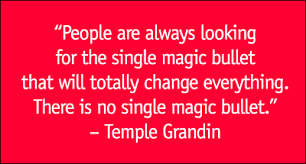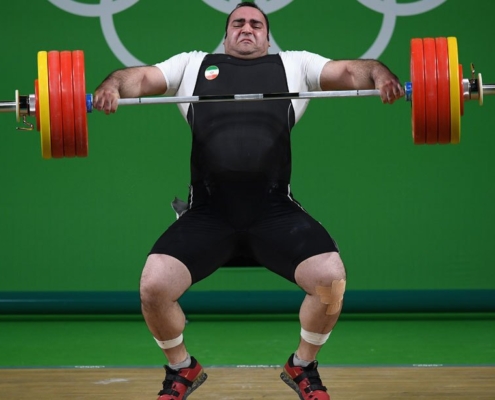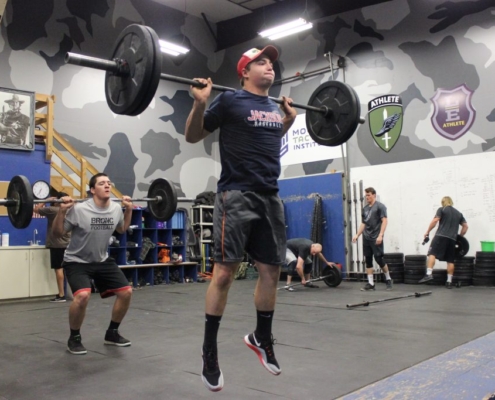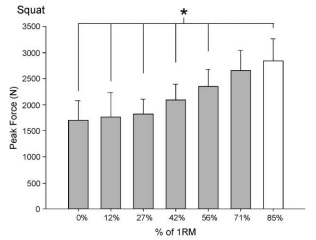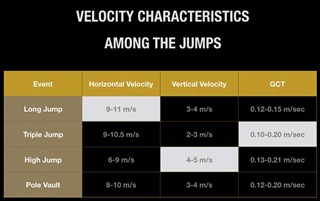Does the Jump Squat Fail to Deliver?
As part of APA’s goal to be the Best Tennis S&C Team in the World I am reviewing the #APA Method and have been identifying and questioning my assumptions about various aspects of the method. This is one of several posts looking at the concept of ”Power.” It started with my review of Triphasic Method by Cal Dietz – Part 1 and Part 2. I then wrote a series on the Force-Velocity curve for Tennis- Part 1 and Part 2.
In between those I wrote a specific blog – Is There Any Evidence That Surfing the Curve is Important?
This was in response to an instagram discussion lead by @jump.science who was calling into question the middle of the curve.
”If I’m training for speed/jumping I should definitely sprint and jump. These are already the ultimate explosive training stimulus. Compared to these, exercises like loaded jumps and Olympic lifts are relatively slow with long time frames for force production. Thus they have no explosive benefits to offer. They can only serve as strength training.
So if we skip cleans and just deadlift or skip loaded jumps and just squat, do we sacrifice much of anything? Do we need to break our lifting into 4 categories and make sure we hit each one? I would argue No.”
I should stress that strength and power work as it relates to various versions of squats – including heavy squats (>85% 1RM), explosive squats (60-80% 1RM), ballistic jump squats (30-60% 1RM) and unloaded jump squats are all general and specific preparatory means of training. So don’t think that my proliferation of posts and blogs in recent weeks has made me lose perspective – squatting is one of many means to prepare the athlete for enhanced performance in their sport.
There are No Magic Bullets
To this end, before I get to my comments on Ballistic strength I also want to include some wisdom from Carl Valle who is one of the main contributors on the Simplifaster blog. In his blog – Why Force-Velocity Training Concepts Fail to Deliver – he states:
”Coaches are scrambling to find the latest formula or training method to merge sport science and practice with athlete development. It seems everyone in sports performance is dissecting the data from force plates or looking at the velocities of player tracking information to see if their sled training is working. Without a framework on how to construct a training program to improve the force-velocity relationship and athlete training, the science is just not useful.
I believe in force-velocity analysis, but believing that training is about a load or a speed profile isn’t new, and the approach doesn’t work as well as it’s claimed. Don’t dismiss force-velocity research or training ideas, just ask how much of it works and what needs to change in training, as 3- to 4-week pre-seasons are not enough to make a real difference in games.”
He also points out the limtations of the Force-Velocity relationship – something I also did in my review of the Triphasic method.
”The force-velocity curve is misleading, as sprinting’s high velocity does not mean the forces involved are low. How does an athlete run with forces higher than several times their body weight and do it quickly with amazing amounts of coordination? Shouldn’t the force output of running at maximal speed be very, very low due to the high velocity? Concept diagrams are interesting theories, but abstract ideas are not facts.
The X-Y graph of the force-velocity curve does not represent athletic or human performance. Rather, it’s an early attempt to explain muscle physiology. The curve may not be an accurate illustration—it’s meant to explain a concept rather than represent a true working model. Several researchers have noted that the true shape of the chart is neither linear nor hyperbolic, and the contractile properties do not fit into a simple line plot- for example, eccentric actions may change the architecture of propulsive muscle groups due to the plasticity of the tissues from adaptation responses. This will change muscle contraction without increasing neuromuscular force or power from conventional sources.
Simplified charts help take people from ignorance to awareness; it’s up to coaches and the sport science community to go beyond the hype. An athlete can improve their ability to apply more force faster and see an improvement in their jump testing data. But trying to transfer that physiological change to ice hockey speed on a rink may be disappointing.”
Recap on Explosive Strength
I feel I already made a pretty good argument for the inclusion of cleans (and other Olympic weightlifting derivatives) for the benefit of Explosive strength- in the blog Is There Any Evidence That Surfing the Curve is Important?
The inherent high force, high velocity nature of weightlifting exercises creates the potential for these exercises to produce large power outputs across a variety of loading conditions. They significantly improve not only maximal power output but, more specifically, power output against heavy loads. Thus, the use of these movements in training is ideal for athletes who are required to generate high velocities against heavy loads including wrestlers, rugby union front rowers and American football linemen.
So this blog is going to focus on Ballistic strength and make an argument for the benefit of including lightly loaded jumps into our programming.
Training for RFD – Ballistic Strength
Ballistic strength is the category of strength training that @jump.science feels is most pointless which is commonly known as speed-strength, and includes lightly loaded jumps.
At APA we use 30-60% 1RM for the Jump squat as a go to loading scheme for Ballistic strength. Full disclosure; the science I referred to in the last blog didn’t make a clear case for doing loaded jumps in favour of say plyometrics.
That’s because the power group did bodyweight jumps and jump squats with 30% 1RM. This means we can’t separate their effects.
[The power training only group did two sessions per week using body mass jump squats (7 sets x6 reps) and one session per week where they performed 5 sets x 5 reps of maximal effort jump squats with 30% 1RM].
What Does The Research Say?
In terms of peak power we can’t really make an argument for loaded jumps over unloaded jumps- peak power is always highest at body weight.
I wanted to focus in on a comparison of the Back squat versus the Jump squat in the study of the Optimal Loading for Maximal Power Output during Lower-Body Resistance Exercises – Cormie et al (2007).
Now just for context I have already mentioned in the previous blog the data they provided in the study on isometric peak force, but I’l give it again below:
Peak Force- Isometric squat 4250 N; Isometric Mid-thigh Pull (IMTP) – 3900 N.
At APA we use loads of 30-60% 1 RM for jump squats. There are a few reasons for this. Reason number 1 is because (in all honesty) that’s what Yuri Verkhoshansky’s research was recommending. Reason number 2 is that this load seems favourable from a cost-to-benefit ratio point of view. Doing jumps with heavy-ish loads on the back is a consideration for safety- it’s a lot of vertical spinal compression to have to absorb.
If you look at the peak force for jump squat at 27-56% of 1RM in the research study (which roughly corresponds to the 30-60% range) it’s about 2250 N to 2750 N. If you compare that to the back squat at 85% of 1RM (thought to be the threshold for maximal strength) the peak force looks to be around 2750 N. So the peak forces are actually comparably at 56% 1RM in the jump squat and 85% 1RM in the squat.
The benefit of doing the loaded jumps is that not only do you get great peak forces at take off, you also get the added benefit of eccentric landing forces that need to be absorbed, which is the same benefit for weightlifting.
Loaded Jumps as a Means To Gradually Increase the Training Stimuli
One thing that doesn’t get discussed as much as I think it should do – is exercise selection – for the purposes of teaching developmental athletes how to progressively prepare for higher forms of training intensity.
For example in Yuri Verkhoshansky’s book ” Special Strength Training Manual for Coaches (2011)- Rule one for applying special strength training (SST) means in the training process is – choosing the exercise (what he calls formulating the motor task).
The methods used in SST can be divided as either ‘intensive’ or ‘extensive’:
- Intensive methods – are characterised by maximum power and a small amount of work.
- Extensive methods – are characterised by moderate (sub-maximal) power and an optimal amount of work.
Rule four is to enhance the training potential of SST means. The SST means having a high training potential must be gradually introduced into the training process after training means with a lower training potential.
Athletes with a low level of motor function require a training means with low training potential. The organism is not ready from a functional point of view, to give an adequate adaptive response to their use. We need to constantly and gradually increase the training stimuli.
It is important to increase/enhance the training potential of SST means when the training means cease to ensure the increase parameters of the special work capacity (in other words keep using an exercise until it stops working- and by that I mean it is enhancing the power output in the competitive exercise, whatever that may be).
Since power is determined by two components, force and velocity, the training means included in the SST means system must be able to emphasise:
- the MAGNITUDE of the force-effort in specific movements
- the VELOCITY of the force effort
In SST the shock method and depth jumps as a means of increasing both the force and speed components of the take-off power output is seen as the highest intensity of training stimuli. Barbell and Kettlebell jumps are the bridge between the squat and the depth jump.
Now I’ve said several times already, the body weight version of the jump squat is clearly optimal for maximising power output in the concentric portion of the movement, where peak power occurs at take-off. However, clearly if the most potent stimuli is the depth jump, we know that this has a huge eccentric component. The way I see it, the loaded jump squat is a bridge in eccentric overload between a depth jump (from a box) and a bodyweight jump from the floor.
I’ll take a look at the research for information on the eccentric landing forces for loaded jump squats. Let me get back to you on that!!
Coaching Application
One last thing I wanted to share was an example of the kind of ”shop talk” that goes on on social media. It is great way to see how coaches are applying the science. Let’s start with @jump.science thoughts on it:
”Barbell rhythmic jumps. A speed strength (I think? ??♂️) exercise in which I would say the upward part is insignificant. Slower than a regular jump, too light to build strength, not much value.
———
However the eccentric component is notable. The downward velocity magnifies the influence of the relatively light load and elicits some pretty high muscular forces during deceleration and reversal. One could still argue that if I’m doing dunk sessions and squatting then this is redundant, but one could also argue this is a distinct stimulus that has value. I certainly wouldn’t criticize its use as part of a strength training plan, but I still don’t care what “strength quality” we assign to it.
I could use this to maintain strength if I’m minimizing heavy stuff. Or with a young untrained person, this might actually increase strength a lot.”
@Mike_whiteman77: ”Would agree eccentric overload most beneficial but I personally wouldn’t undervalue the starting strength/ speed strength quality developed and subtlety that is necessary to keep CNS guessing. Also, VmaxPro VBT gives eccentric velocity and bar trajectory to measure your deceleration capabilities and movement efficiency.”
Finally, a really good back and forth between @jump.science and @videnform
@videnform: ”Which type of strength is the loaded, continuous CMJs too light to build and how does that specific strength correlate to performance among elite sprinters and jumpers?
Is performance in the conventional, heavy, full ROM squat which you seem to be biased towards (correct me if I’m wrong) a KPI for sprinting and jumping among a homogenous group of elite athletes?
@jump.science Reply: Too light to improve maximum strength. The observation that increasing squat strength increases athletic performance in many cases. I’m well aware of the gap between the two (sprinting and squatting heavy). The context of that statement [too light to build strength] is that jumping and squatting are already in place. In that case, the upward part of the loaded jump doesn’t develop any type of strength.
@videnform: ”Do you consider resisted sprinting redundant if you are already doing accelerations and classic maximal strength exercises?”
@jump.science reply: ”Resisted sprinting is analogous, yes, and I do think it should only be a small piece of the puzzle. However it’s different because by slowing down a sprint you’re actually just getting more exposure to the specific speed of the early part of the sprint.”
@videnform: ”If that argumentation is followed stringently then slowing down the SSC of a standing CMJ by adding external load will also give you more exposure to specific jumping thus making the exercise relevant.
@jump.science reply: ”that’s non-specific jumping. Because sprinting is multiple steps in a row with changing velocity and contact time. If I do a 20 m resisted sprint, I get more exposure to the EXACT velocities and contact times that occur within the first 5-10 m of a regular sprint, depending how heavy the resistance is. I already explained this.”
What Does The Research Say?
I really like the discussion about what happens if you slow down a sprint with a sled resistance- you are left with speeds and mechanics that approximate the mechanics of acceleration. So what do you get if you add some load on your back when you jump? In terms of peak velocity we can’t really make an argument for loaded jumps over unloaded jumps- peak velocity is always highest at body weight.
Most elite athletes can perform a standing unloaded vertical jump at a peak velocity of 3.5-4.0 m/s. If we compare these peak velocities to those we see at the take off of various competitive jumps it is clear that the take off vertical velocities are all at least 2-3 m/s (see triple jump).
So what happens to peak velocity if you add some weight on your back?
Let’s revisit the comparison of the Back squat versus the Jump squat in the study of the Optimal Loading for Maximal Power Output during Lower-Body Resistance Exercises – Cormie et al (2007).
If you look at the peak velocity for jump squat at 27-56% of 1RM in the research study (which roughly corresponds to the 30-60% range) it’s about 2.0 to 2.75 m/s. Jumping with 27% 1RM still produces more vertical velocity than doing an explosive bodyweight squat (without leaving the ground). More crucially it is still not that far off the take off velocities of the competitive jumping events.
The last question I need to ask myself, which is the most important one as it relates to my sport of tennis, is what are the take off velocities during some of the most important competitive actions in tennis?
Once I answer this I can be truly sure about how closely the jump squat correlates with the speeds experienced in tennis actions.
In my previous blog I wrote: ”In the sport of tennis there are various actions that place high requirements on ballistic strength. Acceleration phase on serves, and ground strokes, as well as most tennis movements within a few metres (see below). Think loaded jump squats (30-60% 1RM), med balls and slow SSC plyos.”
So now I need to test this hypothesis 🙂
I hope you found this article useful.
Remember:
- If you’re not subscribed yet, click here to get free email updates, so we can stay in touch.
- Share this post using the buttons on the top and bottom of the post. As one of this blog’s first readers, I’m not just hoping you’ll tell your friends about it. I’m counting on it.
- Leave a comment, telling me where you’re struggling and how I can help
Since you’re here…
…we have a small favor to ask. APA aim to bring you compelling content from the world of sports science and coaching. We are devoted to making athletes fitter, faster and stronger so they can excel in sport. Please take a moment to share the articles on social media, engage the authors with questions and comments below, and link to articles when appropriate if you have a blog or participate on forums of related topics. — APA TEAM


